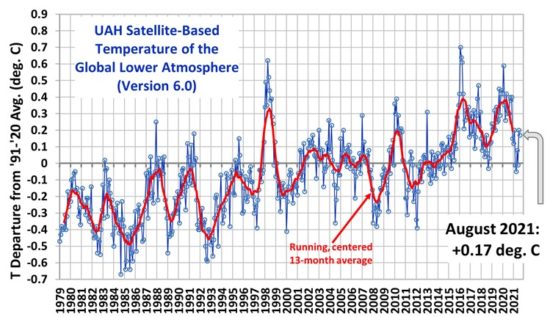The Version 6.0 global average lower tropospheric temperature (LT) anomaly for August, 2021 was +0.17 deg. C, down slightly from the July, 2021 value of +0.20 deg. C.
The linear warming trend since January, 1979 has now dropped slightly, at +0.13 C/decade (+0.12 C/decade over the global-averaged oceans, and +0.18 C/decade over global-averaged land).
Various regional LT departures from the 30-year (1991-2020) average for the last 20 months are:
YEAR MO GLOBE NHEM. SHEM. TROPIC USA48 ARCTIC AUST
2020 01 0.42 0.44 0.40 0.52 0.57 -0.22 0.41
2020 02 0.59 0.74 0.45 0.63 0.17 -0.27 0.20
2020 03 0.35 0.42 0.27 0.53 0.81 -0.95 -0.04
2020 04 0.26 0.26 0.25 0.35 -0.70 0.63 0.78
2020 05 0.42 0.43 0.41 0.53 0.07 0.84 -0.20
2020 06 0.30 0.29 0.30 0.31 0.26 0.54 0.97
2020 07 0.31 0.31 0.31 0.28 0.44 0.27 0.26
2020 08 0.30 0.34 0.26 0.45 0.35 0.30 0.24
2020 09 0.40 0.42 0.39 0.29 0.69 0.24 0.64
2020 10 0.38 0.53 0.22 0.24 0.86 0.95 -0.01
2020 11 0.40 0.52 0.27 0.17 1.45 1.09 1.28
2020 12 0.15 0.08 0.21 -0.07 0.29 0.44 0.13
2021 01 0.12 0.34 -0.09 -0.08 0.36 0.50 -0.52
2021 02 0.20 0.32 0.08 -0.14 -0.65 0.07 -0.27
2021 03 -0.01 0.13 -0.14 -0.29 0.59 -0.78 -0.79
2021 04 -0.05 0.05 -0.15 -0.28 -0.02 0.02 0.29
2021 05 0.08 0.14 0.03 0.06 -0.41 -0.04 0.02
2021 06 -0.01 0.31 -0.32 -0.14 1.44 0.63 -0.76
2021 07 0.20 0.33 0.07 0.13 0.58 0.43 0.80
2021 08 0.17 0.27 0.08 0.07 0.33 0.83 -0.02
The full UAH Global Temperature Report, along with the LT global gridpoint anomaly image for August, 2021 should be available within the next few days here.
The global and regional monthly anomalies for the various atmospheric layers we monitor should be available in the next few days at the following locations:
Lower Troposphere: http://vortex.nsstc.uah.edu/data/msu/v6.0/tlt/uahncdc_lt_6.0.txt
Mid-Troposphere: http://vortex.nsstc.uah.edu/data/msu/v6.0/tmt/uahncdc_mt_6.0.txt
Tropopause: http://vortex.nsstc.uah.edu/data/msu/v6.0/ttp/uahncdc_tp_6.0.txt
Lower Stratosphere: http://vortex.nsstc.uah.edu/data/msu/v6.0/tls/uahncdc_ls_6.0.txt

 Home/Blog
Home/Blog





Good day 🙂
What a good post!
Is it okay I scrape this and share it with my community subscribers?
My blog is about Korean 무료야동ߵ
If your interested, feel free to come to my site and check it out.
Thanks a lot and Keep up the good work!
Thanks in support of sharing such a nice idea,
piece of writing is good, thats why i have
read it entirely
This excellent website definitely has all the info I wanted concerning this subject and didn’t know who to ask.
constantly i used to read smaller content which as
well clear their motive, and that is also happening with this
paragraph which I am reading at this place.
You need to take part in a contest for one of the greatest
blogs online. I am going to recommend this website!